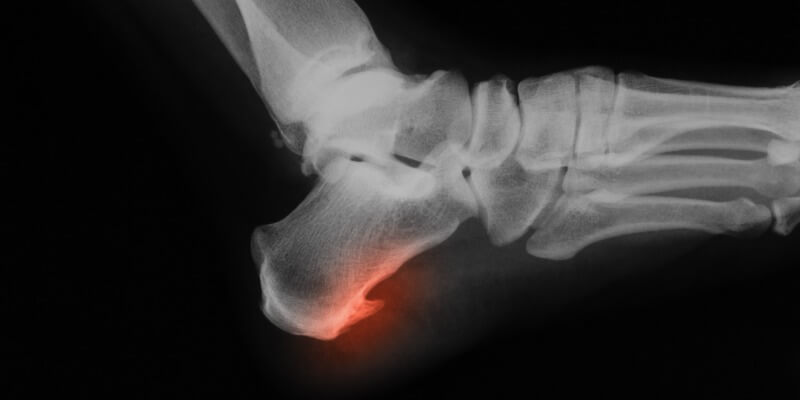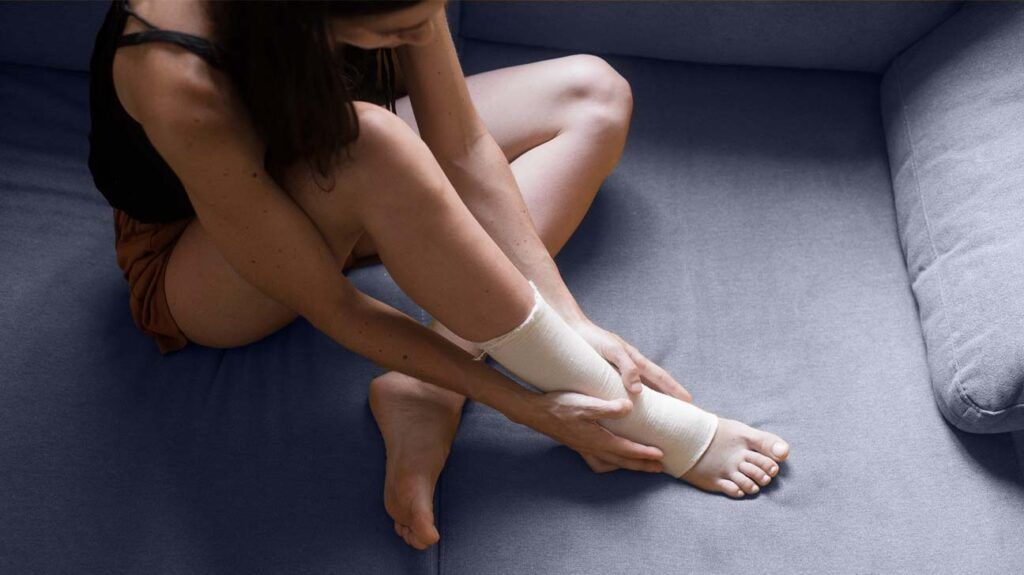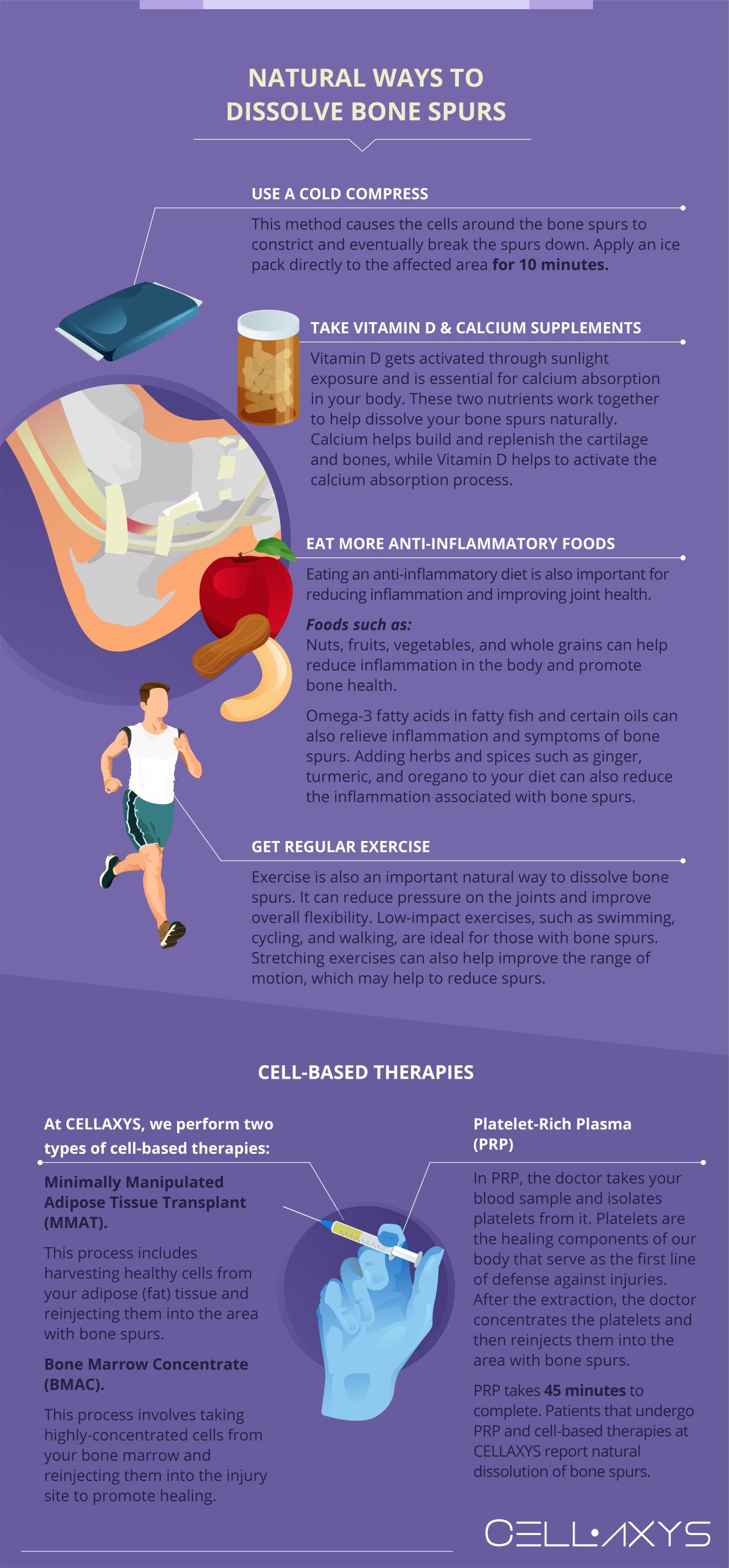To dissolve bone spurs naturally, try incorporating anti-inflammatory foods and supplements into your diet. Regular exercise and stretches can also help alleviate symptoms and prevent further growth.
Bone spurs, also known as osteophytes, are bony growths that can form on bones near joints. While they are often asymptomatic, they can cause pain, stiffness, and limited mobility in some individuals. While medical interventions such as surgery or medication can help manage symptoms, there are also natural remedies that may be effective.
We will explore various ways to dissolve bone spurs naturally, including dietary changes, supplements, and exercises. By incorporating these methods into your lifestyle, you may be able to alleviate symptoms and prevent further growth of bone spurs.

Credit: centenoschultz.com
Introduction To Bone Spurs
Bone spurs, also known as osteophytes, are small bony projections that develop along the edges of bones. While they can develop in any bone, they are most commonly found in joints such as the knees, hips, spine, and shoulders. Bone spurs can cause pain, inflammation, and limited mobility. In this article, we will discuss what bone spurs are, their causes, symptoms, and natural remedies to dissolve them.
What Are Bone Spurs?
Bone spurs are small bony growths that form on the edges of bones. They often develop in areas where bones meet and rub against each other, such as in joints. While some people may not experience any symptoms, others may experience pain, swelling, and limited mobility.
Causes And Symptoms
Bone spurs can be caused by a variety of factors, including:
- Arthritis
- Joint damage or trauma
- Spinal stenosis
- Prolonged wear and tear on joints
Symptoms of bone spurs may include:
- Pain
- Swelling
- Stiffness
- Reduced range of motion
- Difficulty moving the affected joint
If you are experiencing any of these symptoms, it is important to see a healthcare professional for an accurate diagnosis and treatment plan.
Dietary Changes For Bone Health
When it comes to managing bone spurs naturally, making dietary changes can play a crucial role in promoting bone health and reducing the risk of bone spur formation. By incorporating certain nutrients and anti-inflammatory foods into your diet, you can help support your body’s natural ability to dissolve bone spurs and maintain strong, healthy bones.
Calcium-rich Foods
Calcium is essential for maintaining strong bones and preventing the development of bone spurs. Including calcium-rich foods in your diet can provide the necessary building blocks for bone health. Incorporate dairy products, such as milk, yogurt, and cheese, into your meals. Additionally, opt for leafy greens like kale, spinach, and collard greens, which are excellent sources of calcium.
Anti-inflammatory Foods
Consuming anti-inflammatory foods can help reduce inflammation and alleviate the discomfort associated with bone spurs. Fatty fish, such as salmon and mackerel, contain omega-3 fatty acids that possess anti-inflammatory properties. Turmeric is another potent anti-inflammatory spice that can be added to various dishes to support bone health.
Herbal Remedies
Bone spurs, also known as osteophytes, can cause pain and discomfort. While medical intervention may be necessary for severe cases, there are also natural remedies that can help dissolve bone spurs. Herbal remedies, in particular, have been used for centuries due to their anti-inflammatory and pain-relieving properties. Here are two herbal remedies that can aid in alleviating the symptoms of bone spurs:
Turmeric
Turmeric is a vibrant yellow spice commonly used in Indian cuisine. It contains a compound called curcumin, which has potent anti-inflammatory effects. Curcumin can help reduce pain and inflammation associated with bone spurs. Here’s how you can incorporate turmeric into your routine:
- Add a teaspoon of turmeric powder to a glass of warm milk and drink it daily.
- You can also take turmeric supplements after consulting with a healthcare professional.
- Consider adding turmeric to your cooking to benefit from its anti-inflammatory properties.
Ginger
Ginger is another powerful herb known for its anti-inflammatory properties. It contains gingerol, a bioactive compound that can help reduce pain and inflammation caused by bone spurs. Here are some ways to use ginger as a natural remedy:
- Grate fresh ginger and add it to boiling water to make a ginger tea. Drink this tea two to three times a day.
- You can also take ginger supplements, but make sure to consult with a healthcare professional beforehand.
- Incorporate ginger into your meals by adding it to stir-fries, soups, or smoothies.
Remember, it’s important to consult with a healthcare professional before starting any new herbal remedies, especially if you have any underlying health conditions or are taking medications. These herbal remedies can be used alongside other treatments to help manage the symptoms of bone spurs naturally.

Credit: www.medicalnewstoday.com
Supplements That Help
When dealing with bone spurs, certain supplements can aid in natural dissolution. Magnesium and Vitamin D are crucial for bone health.
Magnesium
Magnesium is essential for bone formation and helps regulate calcium levels in the body.
Vitamin D
Vitamin D is vital for calcium absorption in the body, supporting healthy bone growth.
Omega-3 Fatty Acids
Omega-3 fatty acids have anti-inflammatory properties that can help reduce inflammation associated with bone spurs.
Physical Therapy And Exercises
How to Dissolve Bone Spurs Naturally? Naturally dissolve bone spurs by incorporating physical therapy and specific exercises into your routine. These methods can help improve flexibility, reduce inflammation, and strengthen the surrounding muscles, leading to relief and improved mobility over time.
Stretching Routines
Stretching routines can help improve flexibility and reduce pain from bone spurs. Focus on gentle stretches to target affected areas, such as the heels or shoulders.
- Perform calf stretches to alleviate heel bone spurs.
- Shoulder stretches can help with bone spurs in the shoulder region.
Low-impact Activities
Engaging in low-impact activities can alleviate pressure on the affected areas. Opt for exercises like swimming or cycling to strengthen muscles without straining the joints.
- Swimming is an ideal low-impact exercise for bone spur relief.
- Cycling can help improve joint mobility and reduce bone spur discomfort.
Topical Applications
Bone spurs can be effectively managed through natural remedies, with topical applications playing a key role in alleviating pain and inflammation. Here are some effective methods:
Warm And Cold Compresses
Warm compresses help increase blood flow, while cold compresses reduce inflammation and provide pain relief.
Essential Oil Mixtures
Essential oils like lavender and peppermint can reduce pain and inflammation when applied topically.
Lifestyle Adjustments
Lifestyle adjustments play a crucial role in managing and preventing bone spurs naturally. Making simple changes in your daily habits can have a significant impact on reducing discomfort and promoting overall bone health.
Weight Management
Maintaining a healthy weight is essential to alleviate pressure on your joints and reduce the risk of developing bone spurs.
Proper Footwear
Wearing supportive shoes with proper cushioning can help distribute weight evenly and prevent excessive strain on your feet, ankles, and heels.

Credit: cellaxys.com
When To Seek Professional Help
If you are experiencing persistent pain and discomfort caused by bone spurs, it may be time to seek professional help. While there are natural remedies that can help manage bone spur symptoms, there are certain situations where medical intervention may be necessary. Here are some instances when it is advisable to consult a healthcare professional:
Persistent Pain
If the pain caused by your bone spurs persists and becomes increasingly severe, it is essential to seek medical attention. Persistent pain can indicate that the bone spurs are causing further damage or are affecting nearby tissues. A healthcare professional will be able to evaluate your condition and recommend appropriate treatment options.
Surgical Options
In some cases, natural remedies may not effectively dissolve bone spurs, and surgical intervention may be required. Surgical options for bone spurs include:
- Arthroscopic surgery: A minimally invasive procedure where a small camera and surgical instruments are inserted through small incisions to remove or repair the bone spurs.
- Osteotomy: A procedure where the bone with the spur is cut and reshaped to relieve pressure and pain.
- Joint replacement: In severe cases, joint replacement surgery may be necessary to alleviate symptoms caused by bone spurs.
These surgical options should be considered when natural remedies have not provided significant relief or when the bone spur is causing severe pain and interfering with daily activities.
It is important to note that only a qualified healthcare professional can determine the most appropriate course of action based on your specific condition. They will conduct a thorough evaluation and consider factors such as the location and size of the bone spur, the severity of symptoms, and your overall health before recommending any surgical intervention.
Remember, seeking professional help is crucial to ensure an accurate diagnosis and appropriate treatment plan. Do not hesitate to reach out to a healthcare professional if you are experiencing persistent pain or if natural remedies have not provided the desired relief.
Frequently Asked Questions
Faq 1: What Are Bone Spurs?
Bone spurs, also known as osteophytes, are bony projections that form along the edges of bones. They typically develop in response to ongoing stress, pressure, or inflammation in the body. Bone spurs can occur in various parts of the body, including the spine, shoulders, hands, hips, and feet.
Faq 2: What Causes Bone Spurs?
Bone spurs can be caused by a variety of factors, including age-related wear and tear, joint degeneration, osteoarthritis, repetitive motion, and joint instability. Other contributing factors may include obesity, poor posture, improper body mechanics, and genetic predisposition. It is important to address the underlying cause of bone spurs to effectively manage them.
Faq 3: Can Bone Spurs Be Dissolved Naturally?
While bone spurs cannot be completely dissolved, certain natural remedies can help manage the symptoms and slow down their progression. These include regular exercise to improve joint mobility, maintaining a healthy weight to reduce stress on the joints, consuming an anti-inflammatory diet rich in fruits and vegetables, and using hot and cold therapy to alleviate pain and inflammation.
Faq 4: Are There Any Home Remedies For Bone Spurs?
Yes, there are several home remedies that can provide relief from bone spur symptoms. These include applying a warm compress or ice pack to the affected area, performing gentle stretching exercises, taking over-the-counter nonsteroidal anti-inflammatory drugs (NSAIDs), using orthotic devices or shoe inserts for proper support, and practicing good posture and body mechanics to minimize stress on the joints.
Conclusion
Incorporating natural remedies can help alleviate bone spurs discomfort. Prioritize proper nutrition and exercise to support bone health. Consistent lifestyle changes can contribute to reducing bone spur symptoms over time. Stay proactive in managing your health to promote overall well-being and minimize bone spur development.